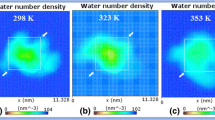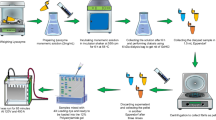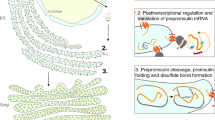Abstract
B9(Ser→Asp) insulin, one of the fast-acting insulin mutants produced by protein engineering, has been crystallized. Three crystal forms have been obtained, which belong to orthorhombic, tetragonal and rhombohedral system, respectively. Each crystal form contains different aggregation units of the mutant, i.e. dimer or hexamer. The diffraction data of the former two have been collected beyond 0.2 nm resolution. The structural analyses and comparisons will provide some information about insulin ’ s self-association and the structural basis of the fast absorption produced from the mutation.
Similar content being viewed by others
References
Brader, M. L., Dunn, M. F., Insulin hexamrs: new conformations and applications,TIBS, 1991, 16: 341.
Xu, W. Q., Zeng, Z. H., Lei, K. J.et al., The molecular design and production of a prolonged insulin mutant,Chinese Journrd of Biotechnology (in Chinese), 1994, 10(2): 142.
Markussen, J., Hougaard, P., Ribel, U.et al., Soluble, prolonged-acting insulin derivatives. I. Degree of protraction and crystallizability of insulins substituted in the termini of the B-chain,Protein Engineering, 1987, l(3): 205.
Markussen, J., Diers, I., Engesgaard, A.el al., Soluble, prolongrd-acting insulin derivatives. II. Degree of protraction and crystallizability of insulins substituted in positions A17, B8, B13, B27 and B30,Protein Engineering, 1987, 1(3): 215.
Markussen, J., Diers, I., Hougaard, P.et al., Soluble, prolonged-acting insulin derivatives. III. Degree of protraction, crystallizability and chemical stability of insulins substituted in positions A21, B13, 823, n27, and B30.Protein Engineering, 1988, 2(2): 157.
Liu, B., Liang, Z. H., Tang, Y. H.et al., Protein engineerering of insulin: [B9Glu] human insulin,Acta Biochimica et Biophysica Sinica (in Chinese), 1996, 28(3): 245.
Brange, J., Ribel, U., Hansen, J. F.et al., Monomeric insulins obtained by protein enginecring and their medical implications,Nature, 1988, 333: 679.
Howard, A. J., Cilliland, G. L., Finzel, B. C.et al., The use of an imaging proportional counter in macromolecular crystallography,J. Appl. Cryst., 1987, 20: 383.
Sakabe, N., A focusing Weissenberg camera with multi-layer-line for macromolecular crystallography,J. Appl. Cryst, 1983, 16: 542.
Higashi, T., The processing of diffraction data taken on a srrcenlcss Weissenberg camera for macromolecular crystallography,J. Appl. Cryst., 1989, 22: 9.
McRee, D.E.,Practical Protein Crystallography, San Diego: Academic Press, 1993, 11.
Thaller, C., Weaver, L. H., Eichele, G.et al., Repeated seeding technique for growing large single crystals of proteins,I. Mol. Bwl., 1981, 147: 465.
Anne Marie M. Jørgensen, Køren M. Kristensen. Jens J. Ledet al., A study of the B9(Asp) mutant of hurnan insulin using nurlear magnetic resonance, distance geometry and restrained nolecular dynamics,J. Mol. Biol., 1992, 227: 1147.
Author information
Authors and Affiliations
About this article
Cite this article
Liu, X., Jin, L., Zhang, Y. et al. Crystallization and preliminary crystallographic analyses of human insulin mutant B9(Ser→Asp) in different aggregation forms. Chin. Sci. Bull. 44, 796–799 (1999). https://doi.org/10.1007/BF02885022
Received:
Issue Date:
DOI: https://doi.org/10.1007/BF02885022




